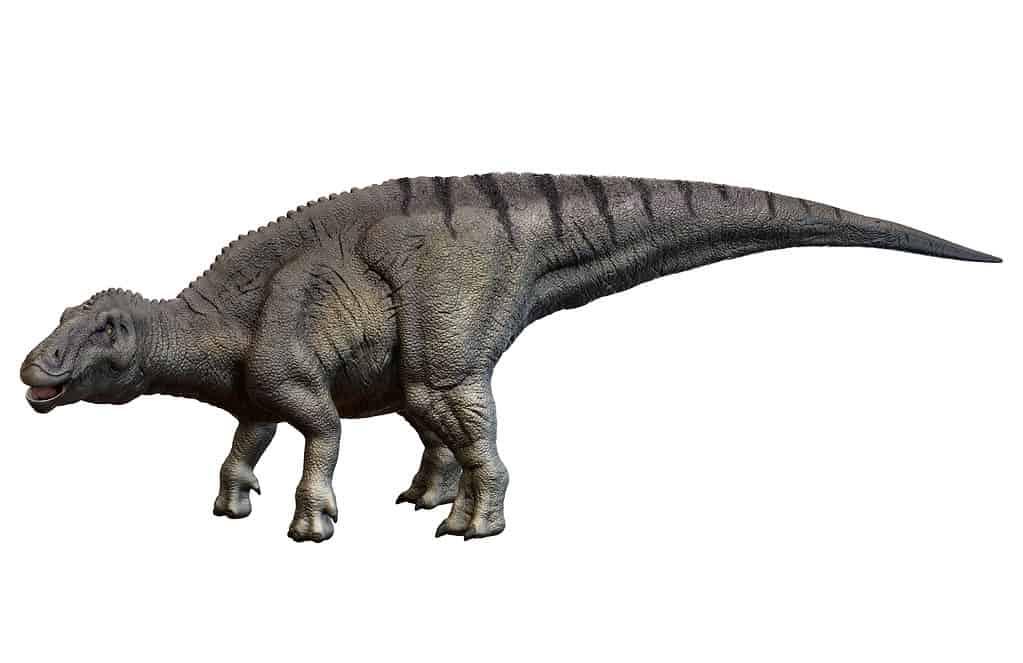Shantungosaurus
Shantungosaurus giganteus
Shantungosaurus was one of the largest duck-billed dinosaurs to have ever lived.
Advertisement
Shantungosaurus Scientific Classification
- Kingdom
- Animalia
- Phylum
- Chordata
- Order
- Ornithischia
- Family
- Hadrosauridae
- Genus
- Shantungosaurus
- Scientific Name
- Shantungosaurus giganteus
Read our Complete Guide to Classification of Animals.
Shantungosaurus Conservation Status
Shantungosaurus Facts
- Group Behavior
- Herd
- Fun Fact
- Shantungosaurus was one of the largest duck-billed dinosaurs to have ever lived.
- Biggest Threat
- Natural disasters, massive carnivorous dinosuars
- Most Distinctive Feature
- Its mouth was modified into a hardened bill
- Distinctive Feature
- It had a unique dentition made of rows of tiny sharp teeth
- Habitat
- Meadows, grass plains, mountains, and forests
- Predators
- Tyrannosaurid dinosaurs like Tarbosaurus
- Diet
- Herbivore
- Lifestyle
- Herd
- Favorite Food
- Pine branches and woody plants
- Type
- Hadrosaurid dinosaur
- Number Of Species
- 1
- Location
- China
View all of the Shantungosaurus images!
The Shantungosaurus was a genus of hadrosaurid dinosaurs that lived during the Late Cretaceous Period, approximately 83 to 74 million years ago. It was a giant dinosaur, holding the title of the largest duck-billed dinosaur (hadrosaurid dinosaur) ever found. Paleontologists have found fossils of the Shantungosaurus across various locations in China, suggesting that they lived in Asia. This massive dinosaur had powerful jaws lined with rows of densely packed teeth. However, it was a herbivore, feeding on pine branches and woody flowering plants.
Description and Size

The name
Shantungosaurusmeans “Shandong Lizard.”
©Herschel Hoffmeyer/Shutterstock.com
Shantungosaurus is a genus of herbivorous dinosaurs that lived during the Cretaceous Period. The name Shantungosaurus means “Shandong Lizard,” a reference to the Shandong province where the first fossil of this dinosaur was first found.
Shantungosaurus giganteus (the only species of this dinosaur found so far) is one of the largest ornithischians (bird-hipped dinosaurs) paleontologists have ever discovered. It had a massive skull measuring about 5.3 feet in length. There have been various estimates for the body length of this dinosaur. The two major reconstructions done so far have a body length of 48 feet and 54 feet. They stood at a height of about 23 feet tall at the shoulder. There is a possibility that the heaviest individuals weighed between 12 to 20 tons.
Research paleontologist Gregory S. Paul proposed in 2016 that earlier estimates for this dinosaur’s size may have been exaggerated. He revised the measurements, putting it at 49 feet in length and 13 tons in mass. Despite this conservative estimate, Shantungosaurus remains the largest hadrosaur.
The Shantungosaurus‘ forelimbs were shorter in comparison with its hindlimbs but were still strong enough to support its great weight. This massive dinosaur had a long, heavy tail. The tail was supported by hardened tendons, which made it quite stiff. Based on the enormous size of the tail, scientists think it may have helped the dinosaur balance its weight while it walked. It had muscular legs with birdlike feet. Each of these feet had three toes ending in hoof-like nails. The toes were webbed and had thick pads in between them for support.
Evolution and History
Xing Xu, the Chinese scientist that described this dinosaur, noticed a lot of similarities between the Shantungosaurus and Edmontosaurus, a slightly smaller dinosaur that lived in North America. These similar qualities led him and his colleagues to conclude that both dinosaurs were related, with the Shantungosaurus being an Asian node of a joint Edmontosaurus–Shantungosaurus clade.
In terms of their anatomy, both animals were practically the same, and the only difference between them was in the greater size of the Shantungosaurus. Both hadrosaurid dinosaurs evolved from a common subfamily of dinosaurs known as the saurolophinids. This clade of hadrosaurids is characterized by the absence of hollow crests on their head as against their crested relatives, the lambeosaurinids.
Generally, the hadrosaurids evolved from the iguanodontian dinosaurs, which were quite popular during the Upper Jurassic, to the Lower Cretaceous Period. They retained the body layout of their ancestors and were a dominant group of dinosaurs towards the close of the Cretaceous. Although Shantugosaurus died off before the end of the period, many species of hadrosaurids were around when the disaster that wiped out all the non-avian dinosaur species took place.
Diet — What Did Shantungosaurus Eat?
Fossil evidence suggests that this Shantungosaurus was an herbivorous dinosaur that primarily subsisted on thorny, low-growing flora. Its diet might have included pine branches and the woody plants that emerged during the Cretaceous.
Like all duck-billed dinosaurs, Shantungosaurus had a horn-covered beak similar to a duck’s bill. However, while some Hadrosaurus species tend to have crested skulls, Shantungosaurus had a more flattened skull.
It had no strong teeth in its beak, but its jaws were filled with rows of tiny teeth numbering over 1,500. The dinosaur’s unique detention is one of its most recognizable traits. They were arranged in 60 and 63 grooves that ran vertically in the dinosaur’s mouth. Each tooth had serrated edges and served as shearing blades for cutting tough plants.
This dinosaur had very flexible joints in its facial bones, which provided remarkable flexibility of movement as it chewed. Paleontologists think that this characteristic may have cushioned the jaw to reduce the stress of chewing tough plant material. It had a huge opening close to its nostrils, which a loose flap of skin may have covered. Experts think the dinosaur could inflate this flap of skin to generate sounds. It also had a large cheek pouch which may have helped to prevent food from falling out of its mouth while chewing.
Habitat — When and Where It Lived
Shantungosaurus lived in Asia during the Late Cretaceous Period. It was alive between 74 and 83 million years ago. Fossils of the Shantungosaurus have been discovered in many parts of China, including the provinces of Hebei, Jiangsu, and Shaanxi (China). It was a land-dwelling dinosaur but may have visited the shores of lakes and other water bodies to find food. They had diverse habitats that may have included meadows, grass plains, mountains, and forests.
Threats and Predators
Shantungosaurus lived during the Late Cretaceous Period, a period of the earth’s geologic history characterized by major natural disasters such as earthquakes and volcanic eruptions. Events like this would have put the population of the genus at risk.
Herbivorous dinosaurs like this also faced a consistent threat from large predators. Although this was a massive dinosaur, big beasts similar in size to the Tyrannosaurus rex could attack and kill it since it did not have any armor or any other defensive mechanism.
Shantungosaurus was capable of running fast on its two muscular hindlegs to escape predators. They also moved in herds to further protect themselves from large predators.
One possible predator of the Shantungosaurus is the Tarbosaurus. This is a tyrannosaurid dinosaur that lived in Asia during the Cretaceous, around the same time as the Shantungosaurus.
Discoveries and Fossils — Where Shantungosaurus Was Found
Scientists discovered fossils of the Shantungosaurus in the Shandong Peninsula of China. The fossiliferous site where the fossils were collected was discovered by paleontologists from the Chinese Ministry of Geology in 1964, and the dig took about two years.
In 1973, scientist Hu Chengzhi published a description of the animal and named it Shantungosaurus, from the word “Shantung,” another name for the Shandong Province where this dinosaur fossil was found.
More recently, scientists found new fossils from this same region. The latest find included skull bones, vertebrae, and limb bones. In 2007, these fossils were assigned to a new species named Zhuchengosaurus maximus. However, further study showed the individual discovered was a Shantungosaurus rather than another distinct species.
Extinction — When Did Shantungosaurus Die Out?
The Shantungosaurus went into extinction about 74 million years ago. This was before the catastrophic event that wiped out all the non-avian dinosaur species about 66 million years ago. Scientists are uncertain of the exact cause of the dinosaur’s disappearance.
Similar Animals to the Shantungosaurus
Similar animals to the Shantungosaurus include:
- Edmontosaurus — The duck-billed Edmontosaurus lived about 73 to 66 million years ago during the late Cretaceous Period. It is one of the largest hadrosaurid dinosaurs and also among the last dinosaurs that walked the planet before they were wiped out at the end of the Cretaceous Period.
- Lambeosaurus — This is a genus of crested hadrosaurid dinosaurs that lived in North America about 75 million years ago. Although distantly related to the Shantungosaurus, this dinosaur had a distinctive hollow crest on its head, which gave it a different appearance.
- Saurolophus — This is a dinosaur genus that lived in Asia and North America during the Cretaceous about 70 million to 68 million years ago. It was one of the few dinosaurs that lived on multiple continents during its life.
Related Animals…
View all 293 animals that start with SShantungosaurus FAQs (Frequently Asked Questions)
When was the Shantungosaurus alive?
Shantungosaurus was a large herbivorous dinosaur that lived in Asia during the Late Cretaceous. It was alive about 84 to 73 million years ago.
How big was the Shantungosaurus?
Shantungosaurus was the largest hadrosaurid ever discovered. Estimates for its length range from 49 to 54 feet, and its mass ranges from 13 to 16 tons.
What hunted the Shantungosaurus?
Shantungosaurus was a massive hadrosaurid dinosaur. However, being a herbivore meant it was vulnerable to predators. Experts think they lived and traveled in herds to protect them from predators. However, this didn’t stop the massive carnivore dinosaurs that lived in the same locations from preying on them. They were probably hunted by tyrannosaurid dinosaurs like the Tarbosaurus, which lived in Asia around the same time as the Shantungosaurus.
Thank you for reading! Have some feedback for us? Contact the AZ Animals editorial team.
Sources
- Britannica / Accessed December 16, 2022
- Prehistoric Wildlife / Accessed December 16, 2022
- Wikipedia / Accessed December 16, 2022


















